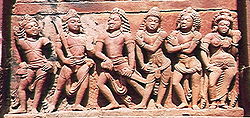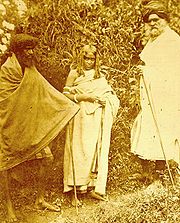
Polyandry in India
Encyclopedia

Polyandry
Polyandry refers to a form of marriage in which a woman has two or more husbands at the same time. The form of polyandry in which a woman is married to two or more brothers is known as "fraternal polyandry", and it is believed by many anthropologists to be the most frequently encountered...
has been practiced in India and is still practiced by a minority. The popular Hindu epic, Mahabharatha provides a striking example of polyandry
Polyandry
Polyandry refers to a form of marriage in which a woman has two or more husbands at the same time. The form of polyandry in which a woman is married to two or more brothers is known as "fraternal polyandry", and it is believed by many anthropologists to be the most frequently encountered...
, Draupadi
Draupadi
In the epic Mahābhārata, Draupadi, also known as ' is the "emerged" daughter of King Drupada of Panchāla and the wife of the five Pandavas. When Yudhisthira becomes the king of Hastinapura at the end of the war, Draupadi becomes the queen of Indraprastha...
, daughter of king of Panchāla being married to five brothers. Polyandry was practiced by some south Indian tribes, prevalent among the Toda
Toda people
The Toda people are a small pastoral community who live on the isolated Nilgiri plateau of Southern India. Before the late 18th century, the Toda coexisted locally with other communities, including the Badaga, Kota, and Kuruba, in a loose caste-like community organization in which the Toda were...
s of Nilgiri
Nilgiris (mountains)
The Nilgiri , often referred to as the Nilgiri Hills, are a range of mountains with at least 24 peaks above , in the westernmost part of Tamil Nadu state at the junction of Karnataka and Kerala states in Southern India...
s, Nair
Nair
Nair , also known as Nayar , refers to "not a unitary group but a named category of castes", which historically embody several castes and many subdivisions, not all of whom bore the Nair title. These people historically live in the present-day Indian state of Kerala...
s of Travancore
Travancore
Kingdom of Travancore was a former Hindu feudal kingdom and Indian Princely State with its capital at Padmanabhapuram or Trivandrum ruled by the Travancore Royal Family. The Kingdom of Travancore comprised most of modern day southern Kerala, Kanyakumari district, and the southernmost parts of...
and Ezhava
Ezhava
The Ezhavas are a community with origins in the region presently known as Kerala. They are also known as Ilhava, Irava, Izhava and Erava in the south of the region; as Chovas, Chokons and Chogons in Central Travancore; and as Tiyyas, Thiyas and Theeyas in Malabar...
s of Malabar. While polyandrous unions have disappeared from the traditions of many of the groups and tribes, it is still practiced by some Pahari
Pahari people
The Pahari people, ; also called Pahadi, Parbati, Khāsā, or Chhetri, are an Indo-Aryan ethnic group of the Himalaya living in Nepal, India, and Pakistan. In Nepal, the Pahari constituted the single largest ethnic group at about 20,000,000, or three-fifths of the Nepalese population through the 1990s...
s especially in Jaunsar Bawar
Jaunsar bawar
Jaunsar-Bawar is a hilly region, 85 km from Mussoorie, in Chakrata tehsil, in Dehradun district, it represents the geographical region inhabited by the 'Jaunsari' tribe, which traces its origin from the Pandavas of Mahabharata....
region in Northern India.
Recent years, have seen the rise in fraternal polyandry in the agrarian societies in Malwa
Malwa (Punjab)
Malwa is a region of Punjab and parts of Haryana between the Sutlej and Yamuna rivers. This Malwa should not be confused with the Malwa Plateau region of Madhya Pradesh, Central India...
region of Punjab to avoid division of farming land.
Toda

Toda people
The Toda people are a small pastoral community who live on the isolated Nilgiri plateau of Southern India. Before the late 18th century, the Toda coexisted locally with other communities, including the Badaga, Kota, and Kuruba, in a loose caste-like community organization in which the Toda were...
s are tribal people residing in the Nilgiri hills in South India who once practiced polyandry. They practiced a form of polyandrous relationship which is considered to be a classic example of polyandry. They practiced both fraternal and sequential polyandry. The males who shared one or two wives were almost always full or half-brothers. Polyandry among Todas existed for several centuries. A Toda woman when married was automatically married to her husband's brothers. One of the husbands who is arranged to perform the ceremony of giving bow and arrow to a child becomes the father when a child is born. When the next child is born, another husband performs the duties and thus becomes a father.
Kerala
Polyandry and Polygamy were prevalent in KeralaKerala
or Keralam is an Indian state located on the Malabar coast of south-west India. It was created on 1 November 1956 by the States Reorganisation Act by combining various Malayalam speaking regions....
till the late 19th century and isolated incidents were reported till mid-20th century. The castes practicing polyandry were Nairs, Thiyyas, Kammalans and a few of the artisan castes. In case of Nairs and other related castes, a man's property is inherited by his sister's children and not his own. Several unrelated men had a common wife in Nair polyandry. Under Nair polyandry, the only conceivable blood-relationship could be ascertained through females. However, polyandry among Nairs is a contested issue with opinion divided between ones who support its existence
and ones who do not support it based on the fact that no stable conjugal relationship is formed in Nair polyandry.
Jaunsar Bawar
Polyandry is still practiced in Jaunsar-Bawar in Uttarkhand. A distinct group of people called PahariPahari people
The Pahari people, ; also called Pahadi, Parbati, Khāsā, or Chhetri, are an Indo-Aryan ethnic group of the Himalaya living in Nepal, India, and Pakistan. In Nepal, the Pahari constituted the single largest ethnic group at about 20,000,000, or three-fifths of the Nepalese population through the 1990s...
s live in the lower ranges of Himalayas in Northern India from southeastern Kashmir
Kashmir
Kashmir is the northwestern region of the Indian subcontinent. Until the mid-19th century, the term Kashmir geographically denoted only the valley between the Great Himalayas and the Pir Panjal mountain range...
all the way through Nepal
Nepal
Nepal , officially the Federal Democratic Republic of Nepal, is a landlocked sovereign state located in South Asia. It is located in the Himalayas and bordered to the north by the People's Republic of China, and to the south, east, and west by the Republic of India...
. Polyandry has been reported among these people in many districts but studied in great detail in Jaunsar-Bawar. It is a region in Dehradun district
Dehradun district
There are five railway stations in Dehradun:* Raiwala* Rishikesh* Doiwala* Harrawala* DehradunAirport...
in Uttar Pradesh
Uttar Pradesh
Uttar Pradesh abbreviation U.P. , is a state located in the northern part of India. With a population of over 200 million people, it is India's most populous state, as well as the world's most populous sub-national entity...
. The practice is believed to have descended from their ancestors who had earlier settled down in the plains from Himalayas. Polyandrous union occurs in this region when a woman marries the eldest son in a family. The woman automatically becomes the wife of all his brothers upon her marriage. The brothers can be married to more than one woman if the first woman was sterile or if the age differential of the brothers were high. The wife is shared equally by all brothers and no one in the group has exclusive privilege to the wife. The woman considers all the men in the group her husband and the children recognise them all their father.
Other tribes
Fraternal polyandry exists among the Khasa of Dehra Dun; and among the Gallong, the Mala Madessar, the Mavilan, etc. of Kerala. Non-fraternal polyandry exists among the Kota; and among the Karvazhi, Pulaya, Muthuvan, and Mannan in Kerala.In 1911 Census of India, E.A. Gait mentions polyandry of the Tibetans, Bhotias, Kanet
Kanet
-History and origin:The word Kanet is said to be derived from the Sanskrit word kunit, which means indifference to caste rules, and the community is said to be descended from Rajputs who abandoned their caste customs...
s of Kulu valley, people of state of Bashahr
Bashahr
Bashahr was a princely state in pre-independence India, located in the hilly western Himalaya promontory in the northern part of colonial Punjab that is now the Indian republic's state of Himachal Pradesh and traversed by the Sutlej river...
, Thakkar
Thakkar
Thakkar or Thakrar, thakkur is a Lohana surname found primarily in the Indian state of Gujarat, and also among Odichya in the Malwa and Nimar regions of Madhya Pradesh, U.P....
s and Megs of Kashmir
Kashmir
Kashmir is the northwestern region of the Indian subcontinent. Until the mid-19th century, the term Kashmir geographically denoted only the valley between the Great Himalayas and the Pir Panjal mountain range...
, Gond
Gondi people
The Gondi, Goindi or Gond people are people in central India, spread over the states of Madhya Pradesh, eastern Maharashtra , Chhattisgarh, northern Andhra Pradesh, and Western Orissa. With over four million people, they are the largest tribe in Central India.The Gondi language is related to...
s of Central Provinces
Central Provinces and Berar
The Central Provinces and Berar was a province of British India. The province comprised British conquests from the Mughals and Marathas in central India, and covered much of present-day Madhya Pradesh, Chhattisgarh and Maharashtra states. Its capital was Nagpur. The Central Provinces was formed in...
, Todas and Kurumbas of Nilgiris
Nilgiris (mountains)
The Nilgiri , often referred to as the Nilgiri Hills, are a range of mountains with at least 24 peaks above , in the westernmost part of Tamil Nadu state at the junction of Karnataka and Kerala states in Southern India...
, Tolkolans of Malabar, Ishavans, Kaniyans and Kammalan
Kammalan
The Kammalan are a caste of Southern India, associated with the crafting of religious items from wood and metal. Their name is derived from the phrase "one who gives the eyes", referring to their providing the eyes for statues of deities....
s of Cochin, Muduvas of Travancore
Travancore
Kingdom of Travancore was a former Hindu feudal kingdom and Indian Princely State with its capital at Padmanabhapuram or Trivandrum ruled by the Travancore Royal Family. The Kingdom of Travancore comprised most of modern day southern Kerala, Kanyakumari district, and the southernmost parts of...
and of Nairs.

